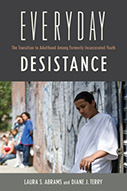Everyday Desistance: The Transition To Adulthood Among Formerly Incarcerated Youth

Author: Laura S. Abrams and Diane J. Terry
Publisher: New Brunswick, NJ: Rutgers University Press, 2017. 256p.
Reviewer: Michael Rocque | October 2018
Research on desistance from crime is still coming of age in criminology. As such, theories are continually being tested and refined, with new theoretical perspectives arriving on the scene regularly. In my recent book on desistance (Rocque, 2017), the chapter on theory discussed more than 20 theories put forth to explain the phenomenon. While the next chapter argued that each theory was a bit too neat and tidy and certainly not comprehensive enough, theorizing is by definition, a process of simplification and tidying up complex issues.
Laura Abrams and Diane Terry’s book Everyday Desistance: The Transition to Adulthood Among Formerly Incarcerated Youth is a reminder to those studying life-course and developmental criminology not to get too far ahead of ourselves when trying to neatly explain desistance from crime. The accounts presented and the deft analysis of those accounts chronicling the journey towards desistance for 25 young adults, puts a monkey wrench in the argument that desistance can be represented well by a simple theoretical model with one or two primary explanations. Their summary of policy implications, suggesting “that there is no one universal program or strategy that can create a pathway toward desistance” (Abrams & Terry, 2016, p. 204) derives in part from their finding that there is no one universal pathway toward desistance in their data.
Abrams and Terry’s work is a welcome addition to the field of desistance. In the rush to theorize why people slow down and eventually stop offending, we may have overlooked the importance of simply presenting people’s narratives as they go about the business of actually doing so. The study stemmed from Terry’s dissertation in which she interviewed 15 young adults attempting to make good after involvement in the justice system. The two scholars then expanded the study to include women, and sought to use their data as a way to illuminate the desistance process—and if it was ever in doubt that desistance is a process, this book puts an end to that—in early or “emerging” adulthood (Arnett, 2004).
In a way, this book is about a particular type of desistance, one that happens after involvement in the justice system. It focuses on re-entry and reintegration processes (which clearly represent a large segment of desisting stories) to the exclusion of desistance among those not involved in the justice system. Researchers seeking to understand the barriers to reintegration will gain as much if not more from this work as desistance scholars.
Chapter 1 provides an introduction to the subject of the book, including what is meant by “everyday desistance” and what the research on desistance from crime has told us so far. Everyday desistance, in this book, is meant to convey the experiences of the normal individual who has committed crime, rather than the polar ends of failure or success story that the authors say is prevalent in the media. The sections on desistance research are a bit brief and gloss over the “rich set of ideas” (p. 7) in the literature, sometimes combining somewhat distinct perspectives. A background in this research would benefit the reader here.
Chapter 2 describes how the 25 participants got into trouble with the law in the first place. Helpfully, this chapter provides context for the research site, which is Los Angeles, California. This is useful in better understanding the obstacles and roadblocks the participants would face upon returning to their communities, including the criminogenic factors present — such as heavy gang activity. The participants were emerging adults (aged 18-25 years old) and had been incarcerated in the past. The researchers identified three pathways to justice system involvement, with illustrative examples. The first included early starters, those who got into trouble at a young age. The second included those who first got into trouble relatively later, and the third included those who had trouble in family life. Notably, these were not neat typologies; rather, participants often experienced more than one type of factor that led to their justice system involvement. What is immediately obvious is that none of the participants “naturally” came to crime, but factors (school, peers, family) pushed or pulled them into it. Additionally, these do not appear to be “life-course persistent” offenders (Moffit, 1993), but those who came to be involved in crime through circumstances in which they found themselves, and for whom circumstances may just as easily set them on the path to the straight and narrow.
The next chapter chronicles the journeys into and out of the criminal justice system for the participants. For the men of color especially, there was a strong feeling of being labeled and stigmatized by the community (and police) as bad seeds, which facilitated justice system entrance. For these subjects, involvement in the system was not a one-time experience, but part of an “endless cycle of placements” (p. 45) that characterized their youth. This chapter also discusses how being incarcerated affected the participants from changing identities to a developing sense of mistrust of the system and its actors. Notably though, the justice system was not a negative experience for all participants. Some made positive connections and gained education in ways they might not have on the outside.
Chapter 4 tells of the struggle for economic stability faced by the participants once in the community. The chapter is divided into two parts, first describing those who were able to make a living and the second covering those who could not. What comes across in this chapter is that “making ends meet” is not as simple as applying for and receiving a job. These participants are dealing with credentialing, family, and housing issues that each make it difficult to simply get by.
In this chapter, we see elements of desistance theory, as some of the participants who found stable work experienced identity changes and steps toward adult maturity. We also see just how difficult it is to maintain employment, despite a commitment and desire to obtain a job. One participant had 20 jobs from age 18 to 24. It would be easy to see figures such as this in quantitative form and draw conclusions: he was a poor employee, had a bad work ethic, etc. The qualitative data provided, however, give us a glimpse into the difficulties he faced. Some jobs were temporary, the hours conflicted with his ability to be a parent, and so on. As the authors state, despite his checkered work history, “Steven…was clearly passionate about taking care of his daughter and took pride in his ability to perform taxing physical labor” (p. 76). For those who could not find employment, we see the effects of being involved in the justice system early on and how that presents structural and internal problems for the subjects.
Chapter 5 delves into the desistance journeys for the men. Abrams and Terry organized the subjects into three typologies according to how far along that journey they were. The first, “on the road to desistance” comprised individuals who were actively desisting and had made decisions to cut off their former criminal lives. The second, “running in circles,” included those who had taken steps toward desistance, but been pulled back into the criminal life, before starting the desistance process over again. These resemble the so-called “zig-zag” trajectories identified in previous research (Piquero, 2004). Finally, the “still in the game” folks had not begun desistance at the time of the study. They were still involved in crime.
It is in this chapter that we see the struggle to exit a criminal career for those without many, if any, privileges. We also gain unique insight on what some of the subjects felt they had to do in order to desist. For example, some of the men not only had to cut off certain former associates and change who they felt they were, but took pains to change how they looked and how they presented themselves to others. This theme of appearance is an interesting contribution to the desistance literature. It is also interesting that for the men, relationships were often a source of support in the desistance process, whereas we learn later that for women, relationships (e.g., romantic partners) often got in the way.
Chapter 6 discusses difficulties with successful transition back into the community and remaining crime free, focusing on stigma and labeling. The subjects feared not only police but also gang members and former associates. For those on the outside looking in, who may not understand why people cannot just get a job and get on with it, the stories illustrating these folks’ struggle just to stay safe and free from harassment are educating.
Chapter 7 moves on to the desistance experiences of the women in the sample. The women who were “making it” appeared to be determined and savvy in terms of finding needed assets. One of the more interesting findings here was the importance of home for these women; they wanted to have stability and a place to call their own in order to launch their new lives. The birth of a child and motherhood was also significant for some of the women in their desistance journeys.
Chapters 8 and 9 connect the findings to theory and policy, respectively. The authors do not try to match their results to any one theory in particular, but note that “a blend of internal and external factors contributed to supporting their desistance goals” (p. 173). As mentioned previously, the findings in this book do not easily fit into existing theoretical models. The authors do seem to wade into theoretical territory though, discussing their theory of everyday desistance, which is that “formerly incarcerated young adults are consciously and unconsciously negotiating decisions around criminal activities, identities, and associations in their everyday and ordinary experiences” (p. 174). This seems more of an observation rather than a theory, however.
The authors argue that internal as well as external factors are necessary for desistance to occur. “Motivation to change” was important, but often not enough. In addition, a degree of luck or randomness was involved for some. In the theory chapter, the authors also take note of some differences they found with respect to gender and desistance.
With respect to policy, the authors discuss prevention, juvenile justice, and emerging adulthood. They note that early experiences are vital and ensuring people are not disadvantaged from birth will go a long way toward preventing much crime. They also suggest dismantling the school-to-prison pipeline and improving child welfare agencies. Adjustments to the juvenile justice system (more focus on programs, less on punishment), and facilitating re-entry conclude their policy implications. In many ways, this is one of the more useful chapters, with concrete recommendations, such as an expiration date for gang injunction policies.
In sum, there is much to be gained from both a policy and theory perspective by reading Everyday Desistance. It is a well-written and engaging study that contributes to knowledge about re-entry and the journey toward desistance. The study is limited by its relatively short time span (the participant in the study for the longest duration was involved for just two years). It is difficult, of course, to know whether the subjects identified as desisting are actually doing so. But, in any case, the study does provide important information on the struggles of formerly incarcerated young adults, most of whom want to desist. We can learn a lot about how to help them reach this goal by reading this book.
References
Moffitt, T. E. (1993). Adolescence-limited and life-course-persistent antisocial behavior: a developmental taxonomy. Psychological Review, 100(4), 674-701.
Piquero, A. R. (2004). Somewhere between persistence and desistance: the intermittency of criminal careers. In Maruna, S., & Immarigeon, R. (Eds.), After crime and punishment: Pathways to offender reintegration, (pp. 102-125). Collumpton, Devon: Willan.
Rocque, M. (2017). Desistance from Crime: New Advances in Theory and Research. London: Palgrave-MacMillan.
Dr. Michael Rocque, Assistant Professor of Sociology, Bates College


